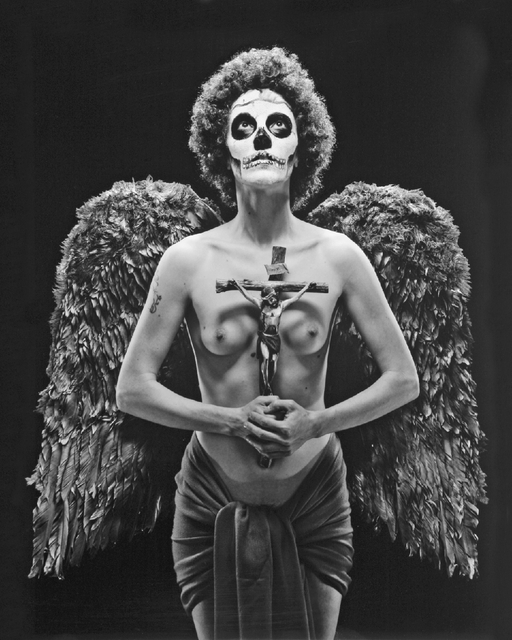The theme of the show, 20 photographers using the same model, is not so much a curatorial endeavor as it is an assignment. Like Fish Story , on view last month at Exhibit 208, the works have a superficial connection through their subject matter, though I got the sense that the fish show was comprised of artists who had already been considering fish as their subjects before being asked to exhibit their work. In the case of 1×20 , the work was clearly crafted for the show—a gimmick that provides little context in which the works can cohere.The exhibition, made up largely of nudes, overwhelmingly by male photographers, prompted my friend to quip that the show be renamed Gang Bang . While this is certainly an exaggeration, the show does its part to reinforce the cliché of art photography as a tacit way for aristocrats to see people naked. One image that illustrates this in a very succinct manner is a black-and-white close-up of the model’s breasts titled Angles . To be fair, I am not a psychiatrist, but I’m pretty sure that the author was concerned only partly with geometry when this image was composed because I can’t imagine anyone saying, “I loved that picture. The one of the angles !”I admit that, upon entering the building, I was unaware of the show’s subtext, but as I moved from artist to artist I had the sensation that the model looked familiar. I dismissed this as a paranoid hallucination and continued.When it became clear that the model, a young woman named Rose, was in fact the subject in each presentation, I was slightly relieved but also surprised by something. Namely, that the use of the same model by 20 separate individuals evoked at least as many similarities as it did differences. These congruencies extended throughout the exhibition, from the scale of the works, to the treatment of the subject, to the facial expressions the photographers were able to elicit from her.Dressed as any number of icons and characters, Rose seemed to retain the control. She looks comfortable in her widely varying roles. Undressed, it is the same story. She is unshakable. After a while the images began to feel distant, and I was keenly aware of the posing involved in so many of the works. When she is not just a nude lump, she is depicted as a saint, a gossip, a movie star, a furniture fetishist, a homicidal housemaid, and even death itself, each time appearing just as confident as before.Rather than showcasing her versatility, this had a numbing effect, diluting the emotional charge the images might have had individually or in another context. This was especially true of Lincoln Draper’s lovely and intimate large-format photos. One, titled And She Cried, shows Rose staring down the camera with fresh tears in her eyes. Is she really crying? Who can say? Alongside all her other roles, it seems unlikely.Viewed simultaneously, the images demonstrate a relationship to subject matter that is decidedly theatrical, melodramatic and (should I?) post-modern! The exhibition reminded me of a posthumous tribute or a retrospective that attempts to celebrate an artist or subject by showing their prowess and durability over a long period of time. Though, with Rose alive and well and unknown to me, what am I supposed to feel?Perhaps I am being conservative, but I found it odd that not one person attempted to show something casual, along the lines of a documentary image or snapshot. I was shown this woman’s body, repeatedly, and how she can act out a persona for the camera, but I ultimately do not feel like I know anything about her. Instead, she was passed from location to location and in many cases treated as though she were little more than a sex toy. If this show was an experiment to test her elasticity, Rose passed, but if photography wants to make claims of revealing truths about its subject, we have some work to do.Which is not to say that all of the images fail. Closet , a surrealist pun on gender by Pat Berrett, stood out as thoughtful and was beautifully crafted, and the strange, war-torn imprints by Kelly Eckel are wholly immune to anything I’ve written here. But I wonder what was the hope, or even the point, for thrusting this restriction onto so many working photographers? To be sure, there is some talent on view here, but the nature of the assignment produces something less like a conversation and more like a bunch of unconnected ideas.




